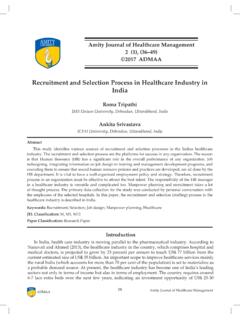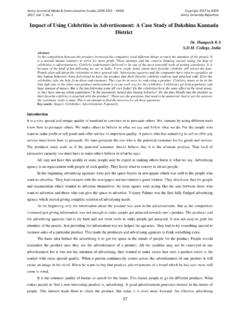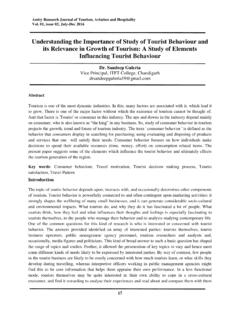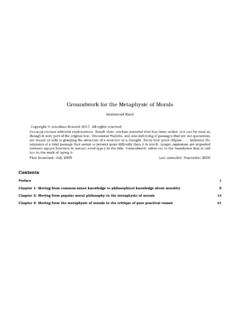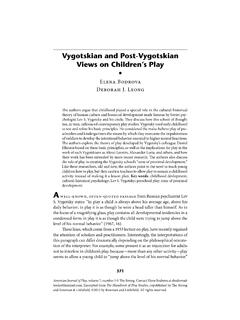Transcription of Capital Punishment: A comparative study
1 77 INTRODUCTION Punishment is the coercion used to enforce the law of land which acts as one of the pillars of modern civilization. It is the duty of the State to punish the criminals in order to maintain law and order in the society. In the past, there wasn t any specific law or order for such crimes and the quantum and extent of punishment was largely dependent on the King. With time modern theories of punishment were developed and voluntary submission of our rights and power to maintain law and order was given to state. The most brutal or we can say the highest punishment awarded in present time is Capital Punishment . Capital punishment is the punishment which involves legal killing of a person who has committed a certain crime prohibited by the law1. Capital punishment is also known as Death Penalty which is sanctioned by the government in which a person is put to death by the state as a punishment for the crime he sentence condemning a convicted defendant to death is known as Death Sentence and the act of carrying out the death sentence is known as Execution.
2 1. Roger Hood, Capital Punishment, Encyclopaedia Britannica, , the court awards a punishment there is a theory or proposition on the basis of which it passes its Judgment. These theories are known as Theories of Punishment and are generally of five types: 1. Deterrent Theory 2. Reformative Theory 3. Preventive Theory 4. Retributive Theory 5. Expiation TheoryThe word Abolition of Death Penalty is one of the most discussed topics in United Nation (UN) where Death Penalty is considered as a violation of Human Rights. UN laid more emphasis on Reformative Theory of Punishment rather than the Deterrent Theory of Krishna Iyer in the case of Rajendra Prasad V. State of Uttar Pradesh commented that- The special reason must relate, not to the crime but to the criminal. The crime may be shocking and yet the criminal may not deserve the Death Penalty2.
3 2. Rajendra Prasad vs State of UP, 1978 AIR Punishment: A comparative studyAbhinav NarayanStudent Amity Law School, NOIDA, AUUPA bstract Capital Punishment or Death Penalty is the highest level of punishment awarded in any society or democracy to maintain law and order. But killing another human being in the name of justice is no better than murdering someone. We should focus on eliminating the crime not the criminal. China is the only country in the world where the practice of death penalty is still at its peak with over 1000 executions every year, whereas in India the doctrine of Rarest of the Rare is followed and often the death sentence gets commuted to life imprisonment. But still India has executed a total of 4 criminals from the period of 2002 to the countries have various similarities in the procedure and law of Capital punishment, but in China once the death penalty is awarded it cannot be revoked.
4 This is the reason why United Nation (UN) opposed the concept of death penalty and stated that Life is precious, and death is irrevocable . Further UN also said that killing another human being in the name of justice also kills the fact that we are human. We are no one to decide who gets to live and who gets to die. Therefore instead of hanging someone to death we should adapt a different approach the reformative approach so that one could improve himself and can live peacefully Punishment: A comparative study78 Whenever a Punishment is awarded for the wrong doing there are two main reasons for inflicting such punishment; 1.) One is that the person who committed the wrong must suffer for it. 2.) And, the other one is that inflicting punishment on wrongdoer acts as an example for India deciding the case for death penalty is based on doctrine of rarest of the rare test which was stated in the case of Bachan Singh V.
5 State of Punjab. Which means that death penalty will only be awarded in rarest of rare cases , in the case of Macchi Singh & Others V. State of Punjab5- the Three Judge Bench followed the decision of Bachan Singh and stated that only in rarest of rare cases when collective conscience of community is in such a way that it will expect the holders of the judicial powers to inflict death penalty then it can be awarded if- 1.) When the murder is committed in an extremely brutal, revolting or dastardly manner so as to arouse intense and extreme indignation of the community. 2.) When a murder of a member of a Scheduled caste is committed which arouse social wrath. 3.) In case of Bride Burning or Dowry Death . 4.) When the crime is enormous in proportion. 5.) When the victim of murder is- An Innocent child A vulnerable Women or a Person rendered unaided by mature epoch or illness.
6 Once the injured party is a individual in relation to whom the slaughterer is in point of authority or reliance. 4. Bachan Singh vs State Of Punjab, AIR 1980 SC 898 (Y Chandrachud, A Gupta, N Untwalia, P Bhagwati, R Sarkaria) 5. Machhi Singh And Others vs State Of Punjab, 1983 AIR 957 (Thakkar, (J)).If we take a look at the Theories of Punishment we can say that the Reformative Theory has its fair share of advantage over Deterrent Theory. Because, in Reformative Theory there is a Scope of Improvement present whereas in Deterrent Theory this scope is completely India, the prisoners of Tihar Jail make Essence Sticks and DhoopBatti which is a good way to make them adjust or flexible with the society. Whereas, on the other hand in Deterrent Theory there is no essence of humanity neither it provides the scope for Penalty is a very serious topic as it means taking away the life of a person which is a very sensitive issue.
7 This is the reason why questions are raised against countries like China, India, USA, Arab countries for awarding Death these countries China alone carries out maximum number of executions with over 60% in number. Whereas in India Capital Punishment is given in rarest of rare cases. The punishment of death is extreme and severe; therefore it should only be used as a last we discuss Capital Punishment with the members of our society then we will be getting two views from it-There will be a section of people who believes that, the person who has committed the crime deserves to die. Whereas, on the other hand there will be people with the view that,the person who committed the crime should be given a second chance, it is not our place to decide who gets to live and who gets to die. Further, taking away a life of an individual in the name of law is not - 1 Capital PUNISHMENT IN INDIA We are all the creation of god.
8 I am not sure a human system created by a human being is competent to take away a life based on artificial and created evidence .- Abdul Kalam3 3. 11th President of India from 2002 to 2007 Capital Punishment: A comparative study79 The Law Commission in its previous review in the year 1967, the commission concluded that India couldn t risk the experiment of abolition of Capital punishment . But in 2015 the Commission stated that the commission feels that the time has come for India to move towards abolition of the death penalty the fact that death sentences are rarely executed in India, still the commission suggested that the penalty should be abolished. The commission gave following reasons:- 1.) Times have changed. 2.) It s not a Deterrent. 3.) India s justice system is of Execution and Commutation of Capital Punishment in IndiaIn India, the concept of death penalty is present but there were only 7 executions done from year 1998-2018.
9 Between 2004 and 2013 there were a total 1303 Capital punishment verdicts but still only 3 convicts were executed between this period. From 2004 to 2012 not even a single execution was the last 20 years a total of 3751 death sentences were commuted to life imprisonment. In July, 2007 Yakub and 11 others were convicted with sentence to death. By special court for planning or carrying out the 1993 bombing in Mumbai which killed nearly 260 people and injured several March, 2013 the SC upheld Memon s Death sentence, while commuting the death sentence of 10 others to life imprisonment while one died the past 14 years only 4 have been hung till death: 1.) DhananjoyChatterjee (August 14, 2004). 2.) Mohammad Ajmal Amir Kasab (November 21, 2012). 3.) Afzal Guru (February 9, 2013). 4.) YakubMemon (July 30, 2015). 10. Id 11.
10 Id as soon as the injured party is a civic figure as well as murder is committed for political or similar reason rather than personal Doctrine of Rarest of Rare In the case of Bachan Singh V. State of Punjab6, the Supreme Court pointed out its view regarding death penalty that death penalty should be awarded only in rarest of rare cases. This view of Supreme Court was highly supported as it aimed to reduce the use of Capital Ratio Decidenti or the Rule of Law applied by the Supreme Court in the case of Bachan Singh is that- the death penalty is constitutional only if it acts as an alternative to life imprisonment. And same shall be applied in rarest of rare case when the alternative option is unquestionably , in the case of Santosh Kumar Bariyar V. State of Maharashtra the Supreme Court further explained that The rarest of rare dictum only serves as a guideline in enforcing the provisions mentioned in Section 354(3) of CrPC and entrenches the policy that life imprisonment is the rule and death punishment is an Constitution of India under Article 21 states that no person shall be deprived of his Right to Life unless done with due process of law8.



